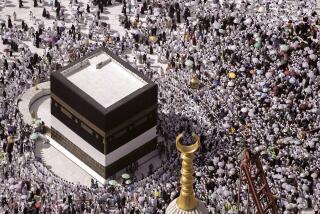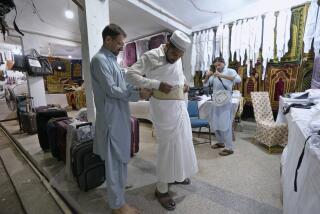Cairo’s a Confusing City but Worth the Challenge
CAIRO — Luxury hotel towers punctuate the smoggy morass of downtown Cairo, rising by the Nile like pristine pink citadels.
Hundreds of tourists, thronging to see the famous tombs and temples of Egypt, keep the revolving doors spinning. Never have so many come so far to see so much that was so dead.
A typical package tour of Cairo, Luxor and Aswan, such as those offered by TWA Getaway Tours, might cost $800 for a two-week excursion in the summer off-season.
Egypt’s controlled economy, its hunger for hard currencies, and a drought of American tourists have made touring here a relative bargain, even with air fare added.
I traveled throughout Egypt for two months as a researcher for “Let’s Go,” a series of travel guides published by Harvard Student Agencies. Researchers are paid a per-diem stipend that is intended to cover expenses; the rest is up to us.
The idea is to motivate us to find the best bargains for our readers, typical students traveling on a budget.
Money Left Over
My stipend was calculated at $26 a day. Even without undue privation, I was hard-pressed to spend more than half that.
Cairo presents the greatest challenge to independent travelers, for all roads lead here, only to be immediately lost in impenetrable confusion.
In the resort cities of Luxor and Aswan, where groveling to foreigners is a time-honored custom, the independent traveler will have little trouble getting by. Cairo, on the other hand, has no mercy.
Most tourists visit the Pyramids and the Egyptian Museum and then flee back to their hotel, overwhelmed by the heat, the noise, the crowds and and the phalanxes of crafty souvenir salesmen.
By doing so they miss one of the world’s most concentrated and confused mixture of cultures and histories, where the streets act as time machines, bringing you from the splendor of medieval Islam to the appalling misery of the Third World to the modern industrial state and back again in the space of 50 yards.
Cairo is worth the effort. However, some caution and a tolerance for squalor help.
Budget accommodations are from 50-cent flophouses to upper-story pensions and slightly seedy former colonial palaces. A tremendous gap in price and quality separates the Western-run first-class hotels and the second tier of accommodations.
But even if my funds were unlimited, I would still stay at the Windsor Hotel, 19 Alfi Bey St., downtown, formerly an annex to the famous Shepheard’s Hotel.
Ghost of Its Past
The Windsor’s air of faded grandeur will appeal to those with visions of British colonels sipping cold lemonade on the veranda. The hotel offers double rooms at about $14 U.S. a night.
The Grand Hotel, nearby at 17 26th of July St., is similar in price and Orientalist opulence. In comparison, the Nile Hilton and Cairo Marriott charge $50 to $70 U.S. per person a night.
Cairo’s public transportation can get you anywhere at negligible cost, but using the system takes some gumption. The ubiquitous red buses, charging about a nickel a ride, are always packed, sometimes to the point of bearing excess passengers clinging to the outside.
As an alternative, convenient and comfortable taxis cost no more than an American bus--from 25 cents to 50 cents. Hail a taxi by shouting your destination through the open window as it speeds by, even if it has other passengers. If going your way, the driver will stop.
Drivers almost never use the fare meters. Prices seem to be a matter of common consent, and Cairenes always seem to know the appropriate amount.
I soon learned that no Egyptian pays more than a single pound (about 50 cents) for a ride anywhere in central Cairo.
The best restaurants are in the hotels. Impossibly expensive by Egyptian standards, they guarantee fresh ingredients and adequate preparation. I couldn’t afford to eat there, and besides, I wanted to chow down with the locals.
The most convenient place to sample Egyptian cuisine is the popular Felfela restaurant near Tahrir Square at 15 Hoda Shaarawy St.
Chicken and Beans
Sitting amid fluorescent aquariums and stuffed animals, you can have a meal of tammiya (chickpea patties) or falafel and fuul (cooked fava beans, the national dish) for about $2.50.
The Alfi Bey, 3 Alfi Bey St., provides a more sedate atmosphere and good roast meats for similar bargain prices.
A new restaurant, the Five Bells in the upper-crust section known as Zamalek, serves the best food in the most attractive setting in Cairo. Once I discovered it, I kept going back and never spent more than $7.
After finding food and shelter, most visitors head directly for the Pyramids.
Ignore the fellows who offer you a private tour of the Pyramids and Sphinx for only 20. Bus 800 from Tahrir Square will take you for a nickel, or a private taxi will speed you there for 4--but ask to be taken to the Mena House Hotel next to the site, because if you mention the Pyramids the driver will instantly turn tour guide.
During the day, sweating tourists and hordes of hustlers selling cheap souvenirs and camel rides crowd the plateau, so do what the Egyptians do: go at night.
New Cairo, dating from the 19th Century, resembles what Paris or London might look like after a severe population explosion and economic depression. It’s worth an evening’s stroll, if only to see how the Egyptian urban middle class conducts itself.
On the other side of the city, at the foot of the Muqattam hills, the section known as Islamic Cairo splays out. This is the City of the Thousand Minarets. Built and fortified by Arabian sultans and Turkish Mameluke rulers, and once arguably the greatest metropolis of the East, this city is what most tourists never see.
The district is densely populated. People jam the alleys, dragging carts, driving mules, selling, buying and begging.
Muslim Prayers
Five times a day, Muslims enter mosques built 500 years ago or more for prayers. There is no room or time to accommodate tourists here; they must dodge rampaging donkey carts like everyone else.
Five hundred years ago the Khan al Khalili bazaar at the center of the district offered wares from all over the East, freshly unpacked from camel bags.
Today it’s the largest tourist bazaar in the world, its innumerable alleys lined with hundreds of shops selling fake Pharaonic artifacts and tacky lamps made of enameled seashells.
Bargaining here is not an art, it’s a survival skill. You can find enameled woodwork, handmade jewelry and fabrics worth the time and effort needed to track them down, and if you approach the merchant with the right mixture of determination, savvy, and humor, you can have a lot of fun. Buy some trinkets, then go eat in El Dehaan on El Muski facing the square; it might be the best shish kebab joint in Cairo.
Egyptians call tourists khawagas, a word connoting wealth and vulnerable naivete.
No matter how strapped a tourist might be, to an Egyptian he or she is rich. Most merchants will charge a foreigner more than an Egyptian would pay, but this unofficial tourism tax is negligible and, some feel, appropriate.
Guided by book or instinct, any venture outside the proscribed bounds for tourists can be rewarding.
For more information on travel to Egypt, contact the Egyptian Government Tourist Office, 323 Geary St., Suite 303, San Francisco 94102, (415) 781-7676.
More to Read
Sign up for The Wild
We’ll help you find the best places to hike, bike and run, as well as the perfect silent spots for meditation and yoga.
You may occasionally receive promotional content from the Los Angeles Times.






